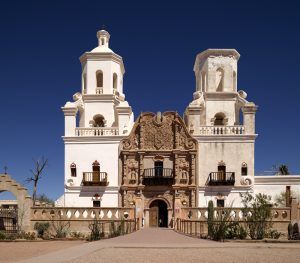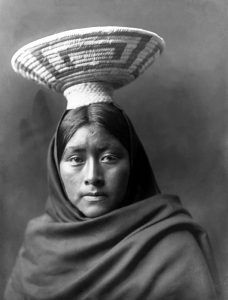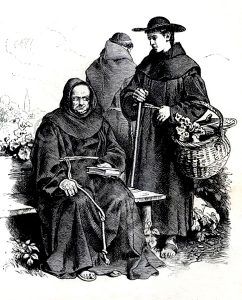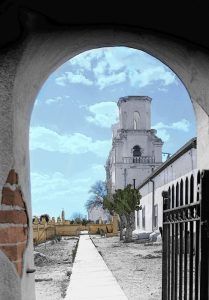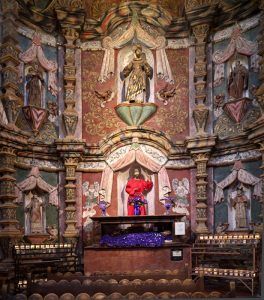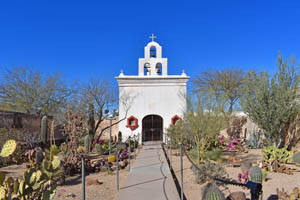A National Historic Landmark, San Xavier Mission in Arizona was founded as a Spanish Catholic mission by Father Eusebio Kino, a Jesuit Explorer, in 1692. The mission was established in the center of a centuries-old Indian settlement of the Sobaipuri O’odham Indians located along the banks of the Santa Cruz River.
As Spanish colonists moved northward from Mexico into present-day Arizona, claiming more land for New Spain, Jesuit priests founded a chain of missions along the Sonoran Mountain range.
The mission’s founder, Father Eusebio Kino, was a leader of the mission system in New Spain and worked to spread Christianity. He was an explorer and a cartographer as well as a Jesuit missionary. He hoped to take up residency at San Xavier del Bac Mission but died when he was the resident priest at Mission Dolores in Magdalena, Sonora, Mexico, in 1711.
During the 17th and 18th centuries, the Catholic missions were an integral part of Spanish colonization. Missions, usually run by Jesuit or Franciscan friars, created European settlements that allowed colonization to expand the boundaries of Spanish culture and influence. The missions intended to Christianize and Hispanicize Native Americans. At San Xavier del Bac, Jesuits first introduced the Tohono O’odham, a Piman-speaking group also known as the Papago, to domesticated horses and cattle. The Spanish also brought European crops, like wheat. Missionaries transformed the lives of semi-nomadic Native Americans with animal husbandry and permanent, rather than seasonal, settlement. The settlement of San Xavier del Bac near the Santa Cruz River was a Tohono O’odham town called Wa:k, a Piman word for water.
Construction on the mission that still stands began in 1783 under the residency of Father Juan Bautista Velderrain. A loan of 7,000 pesos provided the funds to build the church. He hired an architect, Ignacio Gaona, and a large workforce of O’odham to create the present church. It would take years to complete and it wasn’t until 1797 that the Franciscans finished the job. This was about the same time that the Spanish Empire in North America began to wane.
In 1821, Mexico became a Republic after 11 years of revolution, and the new government demanded allegiance from the Franciscan priests. In 1828, San Xavier del Bac’s resident priest, Father Rafael Diaz, refused to align himself with what he believed was an anticlerical regime and left the church. He was the last priest to reside at San Xavier del Bac for the next 36 years.
The mid-1800s was an unstable period for San Xavier del Bac. In 1853, the Gadsden Purchase land treaty between the United States and New Mexico made the mission a U.S. possession. In 1859, the Catholic Church placed the church under the jurisdiction of the Santa Fe diocese. The diocese, under Bishop Lamy, repaired the church’s exposed adobe brick, and in 1864, Jesuit Father Carolus Evasius Messea resided there for eight months. During Father Messea’s time at San Xavier del Bac, he founded the first public school in Arizona, but the local Pima community lacked interest in the church and limited funding forced the parish to close. In 1866 Tucson became an incipient diocese, and regular services were held at the Mission once again. The Sisters of St. Joseph of Carondelet opened a school at the Mission in 1872. Franciscan Sisters of Christian Charity now teach at the school and reside in the convent. In 1874, the U.S. government established the San Xavier Reservation.
At the beginning of the 20th century, Bishop Henry Granjon ordered renovations and new construction on the church. He oversaw repairs to the church façade and mortuary wall, which were damaged by an earthquake in 1887. Granjon had the entire church replastered and repainted. He also built a wall along the front of the convent and placed an arch at its east end. Grotto Hill, 300 feet east of the church, is a small hillock topped by a white cross. A replica of the Grotto of Lourdes is on the north side of the hill. Bishop Granjon oversaw the construction of this shrine to the Virgin Mary in 1908.
The Franciscans returned to the Mission in 1913, and the church received its first priest since Father Messea in 1913, a Franciscan and native of Tucson named Father Ferdinand Oritz. Since the arrival of Father Oritz, California Franciscans have run the church and served the San Xavier Reservation. In 1947, they founded a school for local Pima children. In 1949, they installed new floors within the church, repaired the roof and walls, and improved living conditions within the convent.
Unlike many other historic Spanish missions from the era, the architecture of the current church at San Xavier del Bac Mission is entirely European. It has no Piman influence on its Baroque style, a mix of Byzantine and Moorish architecture, aside from the desert materials and aspects of the interior imagery. The main building is in the shape of a Latin cross. Two octagonal towers topped with belfries stand at the front of the building. One large dome covers the transept crossing, and smaller domes flank it to the north and south. The mission property includes the main church, mortuary chapel, dormitory, patio, garden, and convent.
Built by O’odham laborers, the main building is composed of adobe bricks set in lime mortar. The exterior walls are painted white stucco. The interior is decorated with intricately painted and carved religious imagery, covering the walls and vaulted ceilings. Wooden statues of Saint Xavier and the Virgin are set into a molded background behind the altar, and throughout the church, there are carved wooden statues of Native Americans and saints. Frescoes depicting the lives of Catholic saints decorate the choir loft and main chamber. The mission is the oldest intact European structure in Arizona.
The beautiful Spanish mission was designated as a National Historic Landmark in 1960. The church continues to serve the residents of the San Xavier Reservation. The church is open to visitors daily, except during special services, and the public is welcome to join the San Xavier community for regular masses.
San Xavier del Bac Mission is located at 1950 W. San Xavier Road, on the Tohono O’odham Nation San Xavier Indian Reservation, nine miles south of downtown Tucson, Arizona, just off of Interstate 19.
It is open daily from 7:00 am to 5:00 pm, except when weddings, funerals, or other special church functions are held. The church gift shop is open 8:00 am to 5:00 pm daily, and the museum is open 8:30 am to 4:30 pm. There is no admission charge.
For more information, visit the San Xavier del Bac Mission website or call 520-294-2624.
©Kathy Alexander/Legends of America, updated February 2022.
Also See:
Mission-Presidio Life in the United States
Source:

